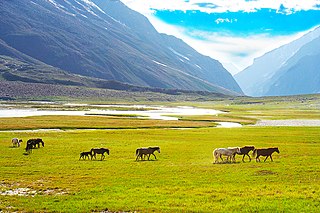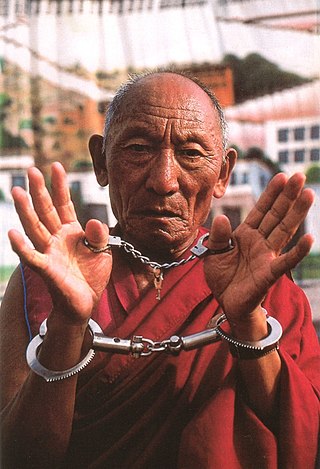
While the Tibetan plateau has been inhabited since pre-historic times, most of Tibet's history went unrecorded until the introduction of Tibetan Buddhism around the 6th century. Tibetan texts refer to the kingdom of Zhangzhung as the precursor of later Tibetan kingdoms and the originators of the Bon religion. While mythical accounts of early rulers of the Yarlung Dynasty exist, historical accounts begin with the introduction of Buddhism from Nepal in the 6th century and the appearance of envoys from the unified Tibetan Empire in the 7th century. Following the dissolution of the empire and a period of fragmentation in the 9th-10th centuries, a Buddhist revival in the 10th–12th centuries saw the development of three of the four major schools of Tibetan Buddhism.

Ngawang Lobsang Thupten Gyatso Jigdral Chokley Namgyal, abbreviated to Thubten Gyatso was the 13th Dalai Lama of Tibet, enthroned during a turbulent era and the collapse of the Qing Dynasty. Referred to as "the Great Thirteenth", he is also known for redeclaring Tibet's national independence, and for his reform and modernization initiatives.

The Suru Valley is a valley in the Kargil District in the Union Territory of Ladakh, India. It is drained by the Suru River, a tributary of the Indus River. The valley's most significant town is Sankoo.
Tibetology refers to the study of things related to Tibet, including its history, religion, language, culture, politics and the collection of Tibetan articles of historical, cultural and religious significance. The last may mean a collection of Tibetan statues, shrines, Buddhist icons and holy scripts, Thangka embroideries, paintings and tapestries, jewellery, masks and other objects of fine Tibetan art and craftsmanship.
This is a list of topics related to Tibet.

Desi Sangye Gyatso (1653–1705) was the sixth regent (desi) of the 5th Dalai Lama (1617–1682) in the Ganden Phodrang government. He founded the School of Medicine and Astrology called Men-Tsee-Khang on Chagpori in 1694 and wrote the Blue Beryl treatise. His name is sometimes written as Sangye Gyamtso and Sans-rGyas rGya-mTsho

Ngapoi Ngawang Jigme was a Tibetan senior official who assumed various military and political responsibilities both before and after 1951 in Tibet. He is often known simply as Ngapo in English sources.

The 1959 Tibetan uprising began on 10 March 1959, when a revolt erupted in Lhasa, the capital of Tibet, which had been under the effective control of the People's Republic of China (PRC) since the Seventeen Point Agreement was reached in 1951. The initial uprising occurred amid general Chinese-Tibetan tensions and a context of confusion, because Tibetan protesters feared that the Chinese government might arrest the 14th Dalai Lama. The protests were also fueled by anti-Chinese sentiment and separatism. At first, the uprising mostly consisted of peaceful protests, but clashes quickly erupted and the Chinese People's Liberation Army (PLA) eventually used force to quell the protests. Some of the protesters had captured arms. The last stages of the uprising included heavy fighting, with high civilian and military losses. The 14th Dalai Lama escaped from Lhasa, while the city was fully retaken by Chinese security forces on 23 March 1959. Thousands of Tibetans were killed during the 1959 uprising, but the exact number of deaths is disputed.
Tritsuk Detsen, better known by his nickname Ralpachen, according to traditional sources, was the 40th king of the Yarlung Dynasty of Tibet. He reigned after the death of his father, Sadnalegs, in c. 815, and grew the empire to its largest extent. He is traditionally said to have been murdered by his brother in 838. Ralpachen is one of Tibet's three Dharma Kings, and referred to as "son of God" in the ancient Tibetan chronicle Testament of Ba.

Tibet came under the control of People's Republic of China (PRC) after the Government of Tibet signed the Seventeen Point Agreement which the 14th Dalai Lama ratified on 24 October 1951, but later repudiated on the grounds that he had rendered his approval for the agreement under duress. This occurred after attempts by the Tibetan Government to gain international recognition, efforts to modernize its military, negotiations between the Government of Tibet and the PRC, and a military conflict in the Chamdo area of western Kham in October 1950. The series of events came to be called the "Peaceful Liberation of Tibet" by the Chinese government, and the "Chinese invasion of Tibet" by the Central Tibetan Administration and the Tibetan diaspora.

Palden Gyatso was a Tibetan Buddhist monk. Arrested for protesting during the Chinese invasion of Tibet, he spent 33 years in Chinese prisons and labor camps, where he was extensively tortured, and served the longest term of any Tibetan political prisoner. After his release in 1992 he fled to Dharamsala in North India, in exile. He was still a practicing monk and became a political activist, traveling the world publicizing the cause of Tibet up until his death in 2018. His autobiography Fire Under the Snow is also known as The Autobiography of a Tibetan Monk. He was the subject of the 2008 documentary film Fire Under the Snow.
Serfs' Emancipation Day, observed annually on 28 March, is a holiday in the Tibet Autonomous Region of China that celebrates the emancipation of serfs in Tibet. The holiday was adopted by the Tibetan legislature on 19 January 2009 and it was promulgated that same year. In modern Tibetan history, the Chinese Premier Zhou Enlai declared the dissolution of the Tibetan government on 28 March 1959 and he replaced it with the temporary Preparatory Committee for the Tibet Autonomous Region (PCTAR), with the Panchen Lama also replacing the Dalai Lama as its acting chairman.

Tibet was a country in East Asia that lasted from the collapse of the Manchu-led Qing dynasty in 1912 until its annexation by the People's Republic of China in 1951.
Tibetan literature generally refers to literature written in the Tibetan language or arising out of Tibetan culture. Historically, Tibetan has served as a trans-regional literary language that has been used, at different times, from Tibet to Mongolia, Russia, and present-day Bhutan, Nepal, India, and Pakistan. Today, the term Tibetan literature can also be applied to any work by an ethnic Tibetan person or arising out of Tibetan folk culture; contemporary Tibetan writers sometimes use Chinese, English, or other languages to compose their work.

The Battle of Chamdo occurred from 6 to 24 October 1950. It was a military campaign by the People's Republic of China (PRC) to take the Chamdo Region from a de facto independent Tibetan state. The campaign resulted in the capture of Chamdo and the annexation of Tibet by the People's Republic of China.

The Tibet Area is a province-level administrative division of China since 1950. It was created after the invasion of Tibet by the Republic of China (1912–1949), and nominally includes the Ü-Tsang and Ngari areas, but not the Amdo and Kham areas. The territories were merely claimed by the ROC, but actually controlled by an independent Tibet with a government headed by the Dalai Lama in Lhasa. The ROC was defeated during the Chinese Civil War; it retreated to Taiwan and lost control of mainland China to the People's Republic of China (PRC) in 1949; afterwards, the ROC continued to claim Tibet.
Buddhists, predominantly from India, first actively disseminated their practices in Tibet from the 6th to the 9th centuries CE. During the Era of Fragmentation, Buddhism waned in Tibet, only to rise again in the 11th century. With the Mongol invasion of Tibet and the establishment of the Mongol Yuan dynasty (1271–1368) in China, Tibetan Buddhism spread beyond Tibet to Mongolia and China. From the 14th to the 20th centuries, Tibetan Buddhism was patronized by the Chinese Ming dynasty (1368–1644) and the Manchurian Qing dynasty (1644–1912) which ruled China.

Robert Barnett is a Professorial Research Associate at SOAS, University of London and Affiliate Lecturer and Research Affiliate at the Lau China Institute, King's College, London. He is the former Director of the Modern Tibetan Studies Program, where he was Adjunct Professor of Contemporary Tibetan Studies and Senior Research Scholar in modern Tibetan history at the Weatherhead East Asian Institute at Columbia University. He retired from Columbia as of January 2018. He is also referred to as Robbie Barnett by the media.
Gyurme Dorje was a Scottish Tibetologist and writer.

Per Kjeld Sørensen is a prominent Danish Tibetologist who specialises in Tibetan and Himalayan history, literature and culture. Since 1994 he has been Professor of Central Asian Studies at Leipzig University, Germany.












